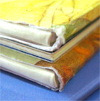|
|
|
|
|
|
|

| 최근 이 책을 구매하신 다른 회원의 책장 |
|
 |
|
|
|
[ 책 소개 ]
* New York Times Best Illustrated Book
* 2004년 Child magazine's Best Children's Book Awards 수상작
널리 알려진 러시아 전래동화인 The Enormous Turnip(커다란 순무)를 중세 르네상스 시대를 배경으로 순무 대신에 아스파라거스로 바꿔서 재구성한 책입니다.
옛날, 왕의 궁전 뒤뜰에 커다란 아스파라거스가 자라기 시작했습니다. 왕은 궁전 건물보다도 높게 자란 이 아스파라거스가 마음에 들지 않아서 뽑아 버리려고 했지만 꼼짝도 하지 않았습니다. 왕비는 아스파라거스가 마음에 들어서 궁전 안으로 옮기려 했지만 역시 꼼짝도 하지 않았습니다. 아스파라거스에 줄을 묶고는 왕과 왕비와 코뿔소와 기사가 모두 힘을 합쳐 뽑아버리려고 했지만 역시 꼼짝도 하지 않았습니다. 낙담한 왕은 어머니를 찾아가서 도움을 청하고, 왕의 어머니는 조그만 작은 새를 이용해 보라고 하네요. 왕은 조그만 작은 새의 몸을 아스파라거스에 묶자, 그렇게도 꼼짝않던 거대한 아스파라거스가 왕과 왕비와 코뿔소와 기사의 힘에 미약한 작은 새의 힘이 더해지자 커다란 소리를 내면서 땅으로 쓰러졌습니다...
조그만 힘이라도 합쳐지면 커다란 일을 이루는데 도움이 될 수 있다는 교훈을 담고 있습니다.
르네상스풍의 진지한 그림과 만화풍의 우스꽝스러운 그림이 묘한 부조화 속의 조화를 이루는 재미있는 그림책입니다.
튼튼한 | 닫기x |  What is 하드커버? What is 하드커버?
양장본이라고도 불리우며, 표지가 단단한 판지로 만들어진 책입니다.
판지를 천이나 가죽으로 감싸기도 합니다. 책의 속지는 일반적으로 중성처리된 종이(Acid-free paper)를 사용해서 잘 변질이 되지 않기 때문에 오랫동안 보관하기에 적합합니다. 이 종류의 책은 더스트 재킷, 또는 더스트 커버로 불리는 표지덮개가 함께 있는 경우가 많습니다. 간혹 내부 속지가 콩기름 코팅이 된 경우 고약한 냄새가 나는 책도 있습니다.
|
[ 서지 정보 ]
Editioin: Hardcover: 34 pages
ISBN-10: 0152167439
ISBSN-13: 978-0152167431
책 크기 : 28.6cm x 22.2cm
[ 영문 서평 ]
Book Description
Long ago in Italy, a mighty asparagus grew smack-dab in front of the king's castle. Was the king happy about it? No. The asparagus had to go. But how does a king reason with an asparagus of such stature?
With tongue planted firmly in cheek, Vladimir Radunsky tells the uproarious tale of an almost immovable vegetable. Drawing on Italian Renaissance art, the esteemed artist creates a breathtaking magical kingdom, where it's easy to imagine that such an asparagus existed. His artwork is as gorgeous as it is funny. Although the old masters may turn over in their graves, readers of all ages will clamor for more of The Mighty Asparagus.
Child Magazine
An asparagus, as tall as a tower, sprouts up in the king's yard. Despite all the efforts of the king, the queen, a knight, and even a rhino, it seems that nothing can uproot it-until a bird flutters its wings "andthe humongous, stupendous, splendid, catastrophic vegetable collapsed!" Underneath the snappy asides and caricatures mixed with Italian Renaissance paintings is a message: Everyone's contributions count, no matter how small.
Child magazine's Best Children's Book Awards 2004
Publishers Weekly
In Radunsky's (Mannekin Pis) gleefully subversive retelling of the Russian folktale "The Turnip," he spoofs Renaissance paintings for his illustrations and changes the locale to an Italianate royal family's court. To the horror of the macho king, a huge, indubitably phallic asparagus stalk pops up in his yard, dominating the palace (and the spreads): "Oh, I hate that stinky asparagus!" he cries. The queen and blushing princess, however, gaze longingly at the enormous vegetable (the princess squeals, "Give it to me now! I want to gobble it up!"; "Funny, I thought that children hated asparagus," the narrator slyly comments). The wink-wink, nudge-nudge jokes to the adults threaten to overwhelm the early pages, but the author/ artist eventually wrestles the satire back on track. Ever the iconoclast, Radunsky raids Italian masterpieces and apologizes to their artists in an arch dedication ("thank you and sorry"). The bumbling king, in his crimson hat and cape, comes from Piero della Francesca, for example, while his imperious advisers are lifted from Andrea Mantegna. Radunsky distorts the characters' haughty faces into Terry Gilliam-esque gooniness, showing readers that museum art (like legendary turnips and asparagus) can withstand a healthy satirical tweaking or two.
Booklist
Interpretations of the Russian folktale "The Enormous Turnip", are legion, but Radunsky's may elicit some furrowed brows. A giant asparagus appears in the courtyard of a king, who despises it; eventually, a small bird succeeds in toppling it after all others fail. The book concludes with a foldout revealing the veggie behemoth surrounded by characters and their elegiac musings ("Such a huge asparagus it was, and now it's fallen and beaten down"). Readers older than the story's usual pictur| 닫기x |  What is What is | 닫기x |  What is e-book? What is e-book?
전자책(electronic book)이라고도 불리우며, 책의 내용을 종이가 아닌 컴퓨터 모니터나 핸드폰의 화면을 통해 읽을 수 있습니다.
|
전자책(electronic book)이라고도 불리우며, 책의 내용을 종이가 아닌 컴퓨터 모니터나 핸드폰의 화면을 통해 읽을 수 있습니다.
|
| 닫기x |  What is e-book? What is e-book?
전자책(electronic book)이라고도 불리우며, 책의 내용을 종이가 아닌 컴퓨터 모니터나 핸드폰의 화면을 통해 읽을 수 있습니다.
|
School Library Journal
For those who love Radunsky's flamboyantly ribald sense of humor, are comfortable with chaos, and accepting of Italian Renaissance art delivered out of context and edited mischievously, this variant of the classic tale "The Turnip" is great fun. It is set in Italy in 1602, the year an enormous stalk of asparagus grew in the king's yard. A combined effort by the monarch, the queen, a rhinoceros, the bravest knight, the princess, and Tiny Little Bird succeeds in dislodging it. "And the humongous, stupendous, splendid, catastrophic vegetable collapsed!" Not much in the text or illustrations makes sense but both scream for attention. The old masters might not be pleased with Radunsky's schoolboy tendency to exaggerate their subjects' noses or white out their eye sockets to fill them in with slightly crossed bug eyes. Part of the book's mischief involves a seemingly mindless inclusion of phallic images. Adolescent? Oh yeah. And no wonder, considering that the artist says he was 13 years old in 1602 according to the book-jacket notes. It's all very amusing, but will children get it? Yes! The lowbrow humor, the blind silliness, and the quirky exaggerations are childishness itself. For older children there is the appeal of random sarcasm and funky, distorted illustrations. |
|
|
|
|
 |
제품상제정보 배송/반품/교환 안내 |
|
|
|
Super Buy 도서는 미국 출판사의 재고도서(Remainder Book), 초과출간도서(Excess Inventory), 할인도서(Bargain Books)
등을 직수입해서 정가의 55%~80%를 할인한 가격에 판매하는 제품입니다.
Super Buy 책의 품질은 거의 새 책과 같은
수준이지만, 간혹 커버의 스크래치나 접힘과 같은 하자나, 책 하단의 재고도서 마크가 있을 수 있습니다.
저렴하게 판매하는 Super Buy 제품의 특성상 반품이 되지 않습니다만, 파본인 경우에는 착불로 반품하시면 책값을
환불해드리거나 적립금으로 올려드립니다. (반품 전에 연락 요망)
하프프라이스북에서는 중고도서(second hand book)를 취급하지 않습니다.
|
|
|
 - 등록된 128,139건의 서평이 있습니다. - 등록된 128,139건의 서평이 있습니다.
| 더보기 
|
|
|
|
|
|
|
 |
|
|
|
|
|
|